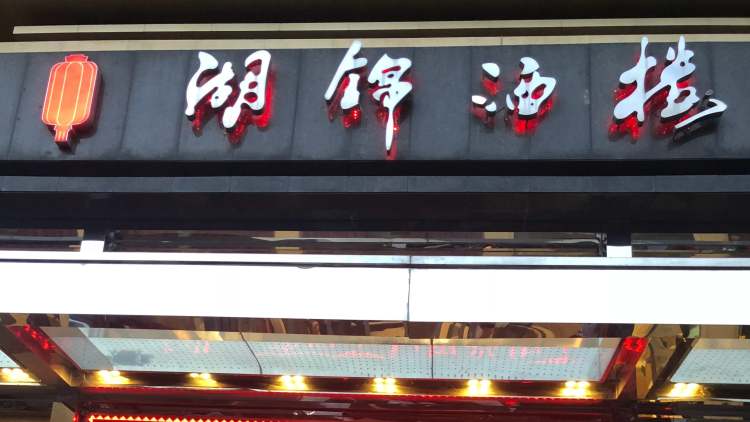Founded in 1994, Hujin is a veteran Hubei restaurant in Wuhan. Over the years, Hujin has been known as the two giants of Wuhan catering together with Kanglong Prince Liquor Restaurant, and has a strong reputation. There is little difference between the two in terms of the level of dishes, the price of Hujin is slightly higher, and the variety of dishes is less. Comparatively speaking, Kanglong Prince Wine Pavilion adheres more to traditional flavors, while Hujin pays more attention to innovation and launches many original dishes, which are more rich in their own characteristics.
The most prestigious original dish of Hujin Restaurant is the spicy one, which is a cold dish with bullfrog as the main ingredient. As the name suggests, the spicy degree is extremely high, and the diners want to jump after tasting it, and the spicy people are all satisfied. The restaurant boils the Indian devil chili king and dozens of spices and herbs into brine, and then selects young frogs about 8 months old, peels and marinates the bullfrog legs. The first feeling of the bullfrog is tender and smooth in the mouth, and then the spicy juice of the bullfrog bursts out, spicy and stings the tip of the tongue, and the chewing finds that the frog meat is salty and fresh, spicy and pure, and makes people eat the aftertaste. Hubei is not as spicy as Hunan and Sichuan, but the tolerance for spicy is not low, and the acceptance of this spicy bullfrog is also quite high. Green onion fragrant duck, old flavor braised beef and crispy crucian carp are also the signature braised vegetables of Hujin, the braised duck is mostly fine meat, crispy and chewy, and the crucian carp is dried after pickling, crispy and salty. In terms of vegetarian dishes, Hujin also has its own innovations. Vegetarian dishes in Chinese food are rarely eaten raw, and Hujin is cold with a sauce made of chrysanthemum, garlic, vinegar, etc., which is refreshing and appetizing.
Chu cuisine is rarely known for cooking freshwater fish, and Wuchang fish is the favorite of Hubei people. Wuchang fish are similar in appearance to bream, but do not belong to the same category, the former has 14 ribs, one of which is shorter, also known as 13 and a half bone spurs, and the latter has 13. Counting bone spurs is not only a way for diners to identify the authenticity of Wuchang fish, but also to add fun to the meal. When it comes to which Wuchang fish is done well, the onion roasted Wuchang fish in Hujin Restaurant can always be in the forefront, one is its good selection of materials, and the other is good seasoning. The restaurant uses Wuchang fish from Fankou, which is about 1 catty and 5 taels, with high fat content and more fatty. After the Wuchang fish is marinated, it is fried in a pan, and then the ginger is added to stir fragrant, and various seasonings are added to boil. After the fish is put on a plate, stir-fry with the soup with chopped green onion and diced chili pepper and then pour over the fish. The sauce is salty and slightly spicy, with a hint of sweet and sour, although it is fragrant, it does not take away the umami of the fish itself, and the seasoning is very skillful.
Compared with Wuchang fish, another freshwater fish, fresh catfish, has more delicate and sweet flesh and fewer bone spurs. Catfish, together with puffer fish and anchovies, is known as the three fresh fish of the Yangtze River, which is well deserved. The cooking skills of the catfish in Hujin are also excellent, the steamed noodles are fragrant and glutinous, the braised flavor is strong, and the soup is fresh and sweet, which is also worth tasting. Among the fresh fish produced in Hubei, Wuchang fish is not the top in terms of meat quality and umami, but human factors have helped it to become the representative of Hubei cuisine. At the same time, compared with the river fresh fish such as osmanthus and catfish, the price of Wuchang fish is lower, which also matches its quality. It can be said that Wuchang fish is not the most high-quality and unique fish species in Hubei, but the most delicious Wuchang fish can be tasted in Hubei restaurants.
Hubei's simmered soup can be described as a must, and the pork ribs and lotus root soup is a representative work. Pork ribs and lotus root are a very common pairing in soups, and the reason why pork ribs and lotus root soup is so famous is very related to the variety of lotus root. The geographical factors of Hubei are suitable for the growth of lotus root, and the starch content of lotus root produced in Honghu Lake and Huangwan is high, and it is easy to rot when boiling soup. In addition, the pork ribs and lotus root soup is made in a unique way, the pork ribs are stir-fried and then simmered with lotus root, and pepper and other ingredients are added, the soup is milky white in color, and it is richer than Cantonese soup. Lotus root soup is also a classic home-cooked dish in Hubei, often appearing on the dining table of most families, for Hubei people, lotus root soup is not only delicious, but also with hometown feelings. This dish is served in almost all Hubei restaurants. And the "taste of home" is the best evaluation of lotus root soup by locals, and Hujin is close to this. The restaurant uses red lotus root from autumn and winter, which has a higher starch content, and uses the traditional technique of simmering lotus root and stir-fried straight row in a casserole hanger. The soup is thick and sweet, the meat is fragrant with the sweetness of lotus root, and the lotus root is crispy and glutinous like mud, the lotus root silk is long, and the stimulation of slightly spicy pepper makes people feel "warm stomach". The meat is not the focus of the lotus root soup, but it is also stewed so that the meat and bones are separated, and it is soft and rotten. Plain but delicious is the best interpretation of pork ribs and lotus root soup.
There are many branches in Hujin, and the dishes are slightly different, but the signature dishes of each store are the same. The décor of the restaurant is no different from that of most restaurants, clean and simple, and spacious enough. Although some branches have been in operation for a long time, they are not old, and the environment is well maintained. The service quality is decent, the waiter is polite and responsive, but not enthusiastic and proactive, and needs to be urged, and the novice is not familiar with the dishes and service process, which is slightly insufficient.
Many local restaurant giants will expand into foreign markets, but Kanglong Prince Wine Restaurant and Hujin rarely expand. The reason for this is related to the dependence of Hubei cuisine on local products, pork ribs and lotus root soup is a microcosm, and many people say that after leaving Hubei's lotus root, the lotus root soup will no longer have an authentic flavor. However, the home-cooked nature of Hubei cuisine makes it inexpensive and unable to afford high transportation costs, so it is difficult to get out of Hubei Province. In order to promote Hubei cuisine, the Hubei Provincial Government changed the name of Hubei cuisine from Hubei cuisine to Chu cuisine in 2018, and gradually determined the list of Chu cuisine and its production standards, but the revitalization of Hubei cuisine is still a long way off.







